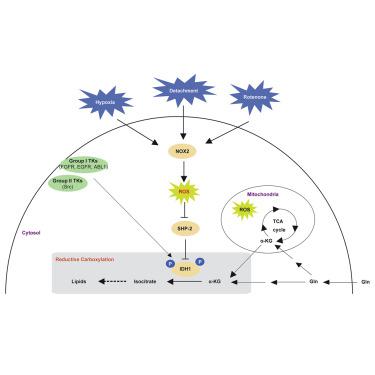Cell Chemical Biology ( IF 8.6 ) Pub Date : 2022-04-15 , DOI: 10.1016/j.chembiol.2022.03.010 Rukang Zhang 1 , Dong Chen 2 , Hao Fan 1 , Rong Wu 1 , Jiayi Tu 3 , Freya Q Zhang 3 , Mei Wang 2 , Hong Zheng 4 , Cheng-Kui Qu 4 , Shannon E Elf 5 , Brandon Faubert 3 , Yu-Ying He 3 , Marc B Bissonnette 3 , Xue Gao 1 , Ralph J DeBerardinis 6 , Jing Chen 1

|
Environmental stresses, including hypoxia or detachment for anchorage independence, or attenuation of mitochondrial respiration through inhibition of electron transport chain induce reductive carboxylation in cells with an enhanced fraction of citrate arising through reductive metabolism of glutamine. This metabolic process contributes to redox homeostasis and sustains biosynthesis of lipids. Reductive carboxylation is often dependent on cytosolic isocitrate dehydrogenase 1 (IDH1). However, whether diverse cellular signals induce reductive carboxylation differentially or through a common signaling converging node remains unclear. We found that induction of reductive carboxylation commonly requires enhanced tyrosine phosphorylation and activation of IDH1, which, surprisingly, is achieved by attenuation of a cytosolic protein tyrosine phosphatase, Src homology region 2 domain-containing phosphatase-2 (SHP-2). Mechanistically, diverse signals induce reductive carboxylation by converging at upregulation of NADPH oxidase 2, leading to elevated cytosolic reactive oxygen species that consequently inhibit SHP-2. Together, our work elucidates the signaling basis underlying reductive carboxylation in cancer cells.
中文翻译:

细胞信号汇聚于 NOX2-SHP-2 轴,诱导癌细胞还原羧化
环境应激,包括缺氧或锚定独立性脱离,或通过抑制电子传递链而减弱线粒体呼吸,诱导细胞中的还原性羧化,通过谷氨酰胺的还原代谢产生柠檬酸分数的增加。这种代谢过程有助于氧化还原稳态并维持脂质的生物合成。还原羧化通常依赖于胞质异柠檬酸脱氢酶 1 (IDH1)。然而,不同的细胞信号是差异性地诱导还原羧化还是通过共同的信号汇聚节点仍不清楚。我们发现还原性羧化的诱导通常需要增强酪氨酸磷酸化和 IDH1 激活,令人惊讶的是,这是通过减弱胞质蛋白酪氨酸磷酸酶(包含 Src 同源区 2 结构域的磷酸酶 2 (SHP-2))来实现的。从机制上讲,不同的信号通过聚合 NADPH 氧化酶 2 的上调来诱导还原性羧化,导致胞质活性氧含量升高,从而抑制 SHP-2。我们的工作共同阐明了癌细胞中还原羧化的信号传导基础。



























 京公网安备 11010802027423号
京公网安备 11010802027423号